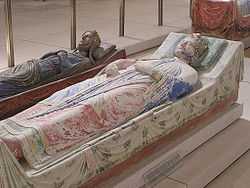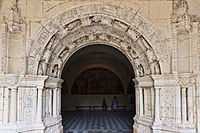Fontevraud Abbey

Fontevraud Abbey or Fontevrault Abbey (in French: abbaye de Fontevraud) is a religious building hosting a cultural centre since 1975, the Centre Culturel de l'Ouest, in the village of Fontevraud-l'Abbaye, near Chinon, in Anjou, France. It was founded by the itinerant reforming preacher Robert of Arbrissel, who had just created a new order, the Order of Fontevrault. The first permanent structures were built between 1110 and 1119.[1] Then located within what is sometimes referred to as the Angevin Empire, the King of England, Henry II, his wife, Eleanor of Aquitaine, and son, King Richard the Lionheart were buried here at the end of the 12th century. Disestablished as a monastery during the French Revolution, it served as a prison from 1804 to 1963.
It is situated in the Loire Valley, an UNESCO World Heritage Site between Chalonnes-sur-Loire and Sully-sur-Loire, and is within the Loire-Anjou-Touraine French regional natural park (Parc naturel régional Loire-Anjou-Touraine).
History

In the early years the Plantagenets were great benefactors of the abbey and while Isabella d'Anjou was abbess, Henry II's widow Eleanor of Aquitaine became a nun there.[2] Louise de Bourbon left her crest on many of the alterations she made during her term of office.

During the French Revolution, the order was dissolved. The last abbess, Madame d'Antin, died in poverty in Paris. On 17 August 1792, a Revolutionary decree ordered evacuation of all monasteries, to be completed by 1 October 1792. The abbey later became a prison from 1804 to 1963, in which year it was given to the French Ministry of Culture.[3] This city prison in Fontevraud, planned to hold 1,000 prisoners, required major changes, including new barracks in addition to the transformation of monastic buildings into dormitories, workshops, and common areas. Prisoners–men, women and children–began arriving in 1814. Eventually, it held some 2,000 prisoners, earning the prison the "toughest in France after Clairvaux." Political prisoners experienced the harshest conditions: some French Resistance prisoners were shot there under the Vichy Government. Following closure of the prison came major restoration, an opening to the public in 1985, and completion of the abbey church's restoration in 2006 under architect Lucien Magne.[4]
Architecture
Church
-

West facade of the church.
-
Chevet.
-

Inside view of the nave.
-
View of the choir, the ambulatory and the choir's chapel.
Cloister
Chapter house
Features
The abbey was originally the site of the graves of King Henry II of England, his wife Eleanor of Aquitaine, their son King Richard I of England, their daughter Joan, their grandson Raymond VII of Toulouse, and Isabella of Angoulême, wife of Henry and Eleanor's son King John. However, there is no remaining corporal presence of Henry, Eleanor, Richard, or the others on the site. Their remains were possibly destroyed during the French Revolution.
Henriette Louise de Bourbon, granddaughter of Louis XIV and Madame de Montespan, grew up here. Princess Thérèse of France, daughter of Louis XV, is also buried there.
Miscellaneous

Jean Genet described the experiences of a thirty-year-old prisoner at Fontevrault in his semi-autobiographical novel, Miracle de la rose, although there is no evidence that Genet was ever imprisoned there himself.
Notes and bibliography
- ↑ Melot (1971)
- ↑ Melot (1971)
- ↑ Melot (1971)
- ↑ "Transformation de l'Abbaye en Prison". l'Abbaye de Fontevraud. Retrieved 19 August 2012.
- Melot, Michel (1971) L'abbaye de Fontevrault. Paris: Jacques Lanore
- Pohu, J. (1961) L'abbaye royale de Fontevrault. Fontevraud: l'abbé Pohu
- Pohu, J. (197-?) The royal abbey of Fontevraud. Fontevraud: l'abbé Pohu
External links
- Official site in French
- Official site in English
- Map of the Loire Valley UNESCO World Heritage Site
- Val de Loire
- Catholic Encyclopedia article
- Royal Abbey of Fontevraud and the famous Gisants (painted tomb effigies) of Eleanor of Aquitaine, King Henry II and King Richard I
- Hotel Abbaye Royale de Fontevraud
| Wikimedia Commons has media related to Fontevraud Abbey. |









